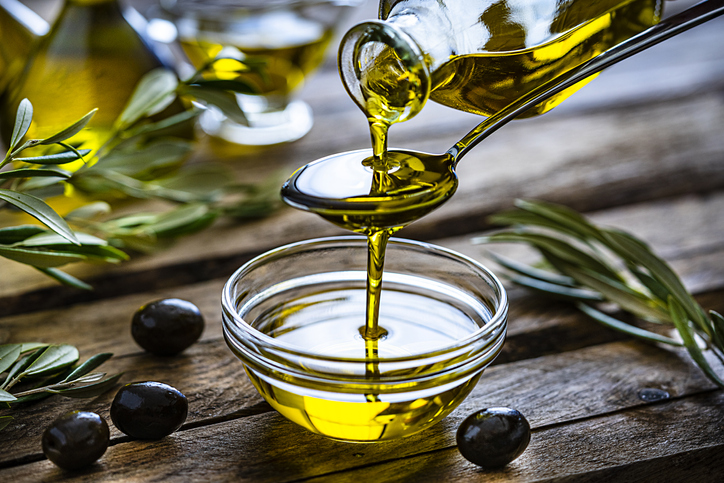
Oleic acid (chemical formula: C18H34O2), is a colourless to pale yellow liquid with a slight fatty odour. Older and commercial grades vary from yellow to red or brown in colour with a more rancid odour. Oleic acid floats on water and is soluble in alcohol, ether, acetone, chloroform, hydrocarbon solvents and oils. Oleic acid is a fatty acid that is naturally occurring in various vegetable and animal fats. Food grades of oleic acid are also available.
Oleic acid makes up a large proportion of various cooking oils such as; olive oil, canola oil, peanut oil, macadamia oil, sesame oil, sunflower oil and grapeseed oil to name a few. It also makes up a large proportion of pork, chicken and turkey fats.
Other uses for oleic acid include its inclusion in; soaps and detergents (as an emulsifier), printing inks, cosmetics and the construction of stained glass.

The routes of exposure for oleic acid include inhalation, ingestion and skin and eye contact.
Inhalation of oleic acid is not thought to produce adverse health effects or irritation of the respiratory tract, however good hygiene practices are still recommended to minimise exposure. Inhalation isn’t typically a concern due to the non-volatility of the chemical, however, at higher temperatures, the risk of inhalation is increased. Inhalation of oil droplets may be hazardous and may cause chemical pneumonitis.
Ingestion of oleic acid has not been classified as “harmful by ingestion”, but the chemical may still have harmful effects on health. This is especially true where an individual has pre-existing organ damage (e.g. liver, kidney). Ingestion may cause nausea and vomiting, however, ingestion of small quantities is not thought to be cause for concern.
Oleic acid can produce moderate skin irritation, inflammation, redness, swelling, blistering and scaling. Entry into the bloodstream through open cuts and wounds may also lead to other harmful effects.
Eye contact with oleic acid may cause irritation. Repeated eye contact may cause; inflammation, redness, temporary vision impairment and other transient eye damage.
If inhaled, remove the patient from the contaminated area to the nearest fresh air source. Other measures are usually unnecessary.
If swallowed, immediately give a glass of water. First aid is not generally required, but if in doubt, contact a Poisons Information Centre.
If skin exposure occurs, immediately remove all contaminated clothing and footwear and flush the affected area with plenty of running water and soap. Seek medical attention in the event of irritation.
If the chemical is exposed to the eyes, flush the eyes out immediately with fresh running water for at least 15 minutes, remembering to wash under the eyelids. Removal of contact lenses should only be done by a skilled individual. Transport to hospital without delay.
Emergency eyewash fountains should be accessible in the immediate area of the potential exposure to the chemical. There should always be adequate ventilation to remove or dilute any air contaminants (install local exhaust if necessary).
The PPE recommended when handling oleic acid includes, safety glasses with side shields, chemical goggles, half face respirators, PVC gloves, PVC apron, overalls and safety footwear/gumboots. Skin cleansing and barrier creams are also recommended in the event of exposure.
Like most chemicals, when handled without the knowledge and know-how, oleic acid can cause harm to yourself and those around you. Always consult your SDS before handling hazardous chemicals. Click here for a trial of our SDS Management Software or contact us at sales@chemwatch.net for more information about our chemicals management solutions.
Chemwatch has the largest collection of SDS in the world. For a FREE copy of the Chemwatch-authored SDS for Oleic Acid, click the button below.